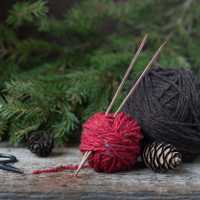How to Read a Knitting Pattern
By Megan Kutchman
How to Read a Knitting Pattern
By Megan Kutchman
Knitting patterns are, for the most part, pretty straightforward. This article is designed to break down and define each section of a knitting pattern so you'll know what information to expect in what section. Not all patterns follow these guidelines, but most do.
Usually the page will start off with a title and photo of the finished product. These are standard and self explanatory. Now on to the juicy stuff:
Skill Level Easy, Medium, Hard or Beginner, Intermediate, Advanced are examples of the information listed here. A quick glance here is how to tell if a pattern is within your skill level.
Here are a few examples of what kind of projects you might find in each skill level:
Easy/Beginner
You'll probably find a lot of scarves here, as well as potholders, place mats, handbags, some afghans and even a few sweaters.
Medium/Intermediate
Stocking caps, cable knitted scarves and sweaters, afghans with alternating stitch patterns and most knitted tops fall under this skill level.
Hard/Advanced
Generally, if an item has a very intricate stitch pattern, it's likely to be in the Hard category. Knitting pictures and designs would definitely be a more advanced undertaking, as would any type of knitting that requires a lot of shaping.
Sizes, Finished Measurements Generally the main size is listed in normal font with all other sizes in parentheses. Example: S(M, L). When you read the knitting instructions further down in the pattern, the first set will apply to the main size, with adjusted instructions for other sizes in parentheses. Also in this section you should see total finished measurements for this project.
Materials Any thorough pattern will list in detail what materials you'll need to complete the project.
-Yarn: Since yarn weights vary by type, look for patterns listing yarn in length, that way you can substitute a yarn and still know how much to get. -Needle Size: You should find information on the needles and needle sizes used to complete this pattern. -Miscellaneous Supplies: If you need stitch markers, cable needles or any other miscellaneous supplies, the pattern should list these here as well.
Gauge The gauge section should read something like this: 10 sts + 10 rows = 4" in Stockinette. This information is what you'll use to check your gauge.
Pattern This is where the actual knitting begins. The pattern tells you what stitches to use in what sequence to create the project named at the top of the page. A complete pattern will also include a list of the abbreviations used, but in some cases, it's assumed everyone knows what those abbreviations mean. Even advanced knitters have trouble with this sometimes.
Some Important Points to Remember
When following any pattern, it is imperative that you: -Test your gauge before starting. There's nothing worse than getting an hour into a project to find it's 6 inches too narrow because your yarn is a smaller weight than the pattern calls for. -Buy all the yarn for the project at the same time. Dyed yarns have "dye lots" and it's important to get all of your yarn for one project from the same dye lot. If you don't, you have a good chance of getting different shades of the same color throughout your knitting. -Take a break if you're frustrated, as you're sure to be at some point. Knitting is a fun and relaxing hobby, don't let it turn into a chore to get that afghan or poncho finished!
Megan Kutchman owns a retail knitting site, http://www.faknitic.com. To learn more about knitting, visit the Knitting Articles resource page on her website.
Article Source: http://EzineArticles.com/?expert=Megan_Kutchman
Knitting patterns are, for the most part, pretty straightforward. This article is designed to break down and define each section of a knitting pattern so you'll know what information to expect in what section. Not all patterns follow these guidelines, but most do.
Usually the page will start off with a title and photo of the finished product. These are standard and self explanatory. Now on to the juicy stuff:
Skill Level Easy, Medium, Hard or Beginner, Intermediate, Advanced are examples of the information listed here. A quick glance here is how to tell if a pattern is within your skill level.
Here are a few examples of what kind of projects you might find in each skill level:
Easy/Beginner
You'll probably find a lot of scarves here, as well as potholders, place mats, handbags, some afghans and even a few sweaters.
Medium/Intermediate
Stocking caps, cable knitted scarves and sweaters, afghans with alternating stitch patterns and most knitted tops fall under this skill level.
Hard/Advanced
Generally, if an item has a very intricate stitch pattern, it's likely to be in the Hard category. Knitting pictures and designs would definitely be a more advanced undertaking, as would any type of knitting that requires a lot of shaping.
Sizes, Finished Measurements Generally the main size is listed in normal font with all other sizes in parentheses. Example: S(M, L). When you read the knitting instructions further down in the pattern, the first set will apply to the main size, with adjusted instructions for other sizes in parentheses. Also in this section you should see total finished measurements for this project.
Materials Any thorough pattern will list in detail what materials you'll need to complete the project.
-Yarn: Since yarn weights vary by type, look for patterns listing yarn in length, that way you can substitute a yarn and still know how much to get. -Needle Size: You should find information on the needles and needle sizes used to complete this pattern. -Miscellaneous Supplies: If you need stitch markers, cable needles or any other miscellaneous supplies, the pattern should list these here as well.
Gauge The gauge section should read something like this: 10 sts + 10 rows = 4" in Stockinette. This information is what you'll use to check your gauge.
Pattern This is where the actual knitting begins. The pattern tells you what stitches to use in what sequence to create the project named at the top of the page. A complete pattern will also include a list of the abbreviations used, but in some cases, it's assumed everyone knows what those abbreviations mean. Even advanced knitters have trouble with this sometimes.
Some Important Points to Remember
When following any pattern, it is imperative that you: -Test your gauge before starting. There's nothing worse than getting an hour into a project to find it's 6 inches too narrow because your yarn is a smaller weight than the pattern calls for. -Buy all the yarn for the project at the same time. Dyed yarns have "dye lots" and it's important to get all of your yarn for one project from the same dye lot. If you don't, you have a good chance of getting different shades of the same color throughout your knitting. -Take a break if you're frustrated, as you're sure to be at some point. Knitting is a fun and relaxing hobby, don't let it turn into a chore to get that afghan or poncho finished!
Megan Kutchman owns a retail knitting site, http://www.faknitic.com. To learn more about knitting, visit the Knitting Articles resource page on her website.
Article Source: http://EzineArticles.com/?expert=Megan_Kutchman



